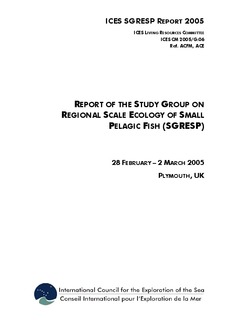| dc.description.abstract | A component of the ecosystem approach to fisheries management is the understanding of the environment induced variability in fish stocks. To start making that component operational, SGRESP was concerned about building the means by which ecological knowledge can serve stock health diagnostic, recruitment projection and management strategy.
A major result from SGRESP in 2004 was the recognition that the environment-population relationship was to be seen as an interaction between the population status (demography and habitat spatial occupation) and the environmental regime. This led to considering the spatiali-sation of the life cycle: spawning habitats, adult migrations, larval survival and incorporation of juveniles to the life cycle of adults. Life cycles have now been documented and survey data inventoried for an extensive list of pelagic populations in ICES waters: anchovy (Biscay), sprat (Baltic and North Sea), herring (Norwegian spring spawning, North Sea, Baltic, Celtic sea and North West Ireland), North East Atlantic sardine, mackerel and blue whiting. Differ-ences in the spatial structure of the life cycles were documented for the different species and a biological framework was build to support spatial population modelling. In particular, being long-lived and still able to reproduce at a small size, sardine showed a complex spatial struc-ture in its life cycle: it showed local independent populations of small fish (a characteristic of anchovy), as well as a large migratory spawning component of bigger fish (a characteristic of mackerel). When spatialising the life cycle essential habitats were identified as well as linkage between generations for the maintenance of their occupation. Habitats were often associated with par-ticular meso-scale oceanographic features which made life cycle closure dependent on these features. Characterising meso-scale oceanographic features was thus recognised essential for the understanding of the variability in spatial patterns and population dynamics. But in gen-eral, environmental parameters available to the fisheries biologist are long-term indices of ocean climate (e.g. NAO). The group recognised the importance to construct long-term series of meso-scale oceanographic features. Tools were presented that allowed to extract from cir-culation model outputs fronts, eddies, vortices, water column stratification. A workshop was proposed to deal with this issue as tools need to be transferred to users for building the long-term time series of the meso-scale features in each area.
SGRESP is an international group which has the capacity and the objective to assemble multi source international data on fish stocks. Long-term variation in anchovy distribution at large scale in ICES waters were studied for the first time. Data were compiled from all available bottom trawl surveys from 1990 to 2004. Anchovy distribution expanded north of 50°N since 1994 and in particular in the North Sea with no particular change in the Southern limits. There was a presumption based on the analysis of fish length that the expansion was due to good recruitments in local northern small relict populations.
Adult spawning behaviour (i.e., spawning windows in space and time) was essential for un-derstanding the influence of the environment on the recruitment dynamics as well as on the long-term variation in population distribution. Following GLOBEC/SPACC conceptual framework which differentiated potentiality, realisation and usefulness in spawning habitats, the group estimated potential habitats for sardine, reported on variation in useful habitats for anchovy and documented changes in realised spawning windows in winter for herring and sprat. The group agreed that realised spawning windows needed to be monitored for ade-quately predicting recruitment. To transfer and incorporate the previous ecological knowledge in stock projection and man-agement, two products from SGRESP were considered: short-term recruitment prediction and medium-term interaction between population status and environmental regime. Guide lines were proposed to operationalize the use of environment-based recruitment indices in popula-tion projection scenarios and to deal with the possibility of inaccuracy in the projection. Propositions were based on applications to Baltic sprat and Biscay anchovy. For the medium-term advice, schemes of life cycle structure with their dependence on oceanographic features represented a biological framework allowing consideration of spatial management strategies. In order to go further, spatial population models and simulation platforms were recognised as necessary tools to be developed. | en |
